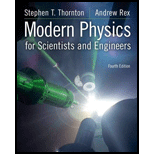
Concept explainers
(a)
The wavelengths that lies in the range of
(a)
Answer to Problem 14P
The wavelength that lie in the range of
Explanation of Solution
Write the expression for the Rydberg’s equation.
Here,
The number corresponding to the Balmer series of hydrogen spectrum is
Conclusion:
For Balmer series:
Substitute
Substitute
Substitute
Substitute
Thus, the wavelength that lie in the range of
(b)
The reason for the visibility of the only three wavelengths by the detector.
(b)
Answer to Problem 14P
The three wavelengths are detected by the detector because the detector is moving away from the source and other wavelength is not visible for the detector.
Explanation of Solution
The wavelengths lying in the visible region are the four wavelengths that should be detected by the detector used. Since the detector is moving away from the source, there is a possibility that the highest wavelength of
Due to red shift, the wavelength would have increased and might have gone out of the visible range of the
Conclusion:
Thus, the three wavelengths are detected by the detector because the detector is moving away from the source and other wavelength is not visible for the detector.
(c)
The speed of the stellar object that emits the spectrum.
(c)
Answer to Problem 14P
The speed of the moving stellar object is
Explanation of Solution
Write the expression for the relation between the observed wavelength and the wavelength from the source.
Simplify and rearrange the above expression for
Here,
Write the expression for the speed of the stellar object.
Here,
Conclusion:
Substitute
Substitute
Thus, the speed of the moving stellar object is
Want to see more full solutions like this?
Chapter 3 Solutions
Modern Physics for Scientists and Engineers
- Knowing that the radius of the earth is 6370 km, determine the time of one orbit of the Hubble Space Telescope if the telescope travels in a circular orbit 590 km above the surface of the earth. (See information given in Probs. 11.153–11.154.)Reference to Problem 11.153-11.154:arrow_forwardWhat is the wavelength of maximum intensity (in nm) and the total energy emitted (in J/s/m2) by a celestial object at 9 K above absolute zero? wavelength of maximum intensity nm ?total energy J/s/m2?arrow_forwardWhen x - ray incident to the layer of Aluminum , and the transmitted intensity was 10 % from the original incident ray when the thickness of Aluminum was 2 cm , if the density of Aluminum is (2.7gm/cm .^3) , then the Half: Value Layer equal to 1.626 cm. O 0.601 cm . O 3.108 cm. O Please I need an answer within 30 minutesarrow_forward
- The radar system of a navy cruiser transmits at a wavelength of 1.6 cm, from a circular antenna with a diameter of 2.3 m. At a range of 6.2 km, what is the smallest distance that two speedboats can be from each other and still be resolved as two separate objects by the radar system?arrow_forwardHomework 2: A geostationary satellite is located at 80°W. Calculate the azimuth angle for an earth station antenna at latitude 34°N and longitude 100°W?arrow_forwardA hollow cathode lamp has a lambda max of 1252 nm at 2473.15 kelvin. The spectral radiance is 1.86 x 10^10 J/m^3s. If the lamp is enclosed in a quartz envelope with a transmission factor of 0.92, what is the spectral emissivity?arrow_forward
- Why do radar satellites typically use a sun-synchronous, dawn-dusk orbit? A. To optimize the collection geometry for higher resolution images. B. To maintain a constant solar zenith angle on the targets. C. To maximize the access time for ground targets. D. To maximize the available power to the solar panels.arrow_forwardA laser with 589 nm wavelength and a beam diameter of 2 mm is fed through a beam-expander,then aimed from the G.O. Jones building to the Canary Wharf tower at a distance of 2.75 km.What expansion factor is required for the beam-expander in order that the diffraction-limited spotat Canary Wharf tower has a diameter of 30 cm (defined as the diameter of the first dark ring) ?arrow_forwardAn early LiDAR system was used to measure the distance to the moon. This system used a wavelength of 530 nm and a pulse-width of 25 nano-seconds. The transmit power was 10-15 Joules/pulse. (a) Assuming the average distance to the moon is 384,000 km, how long would it take for the laser pulse to make a round trip? Provide answer in seconds to two significant digits.The round-trip time is _____ s. (b) The LiDAR system was used to measure the distance to the moon. This measurement had an inherent uncertainty due to the range resolution of the laser. Based on the parameters given above, what was the range uncertainty (i.e. resolution) for this measurement? A. 0.3 m B. 4 m C. 80 m D. 4 kmarrow_forward
- What maximum resolution of a FTIR spectrometer with a 50 cm travelling mirror? a. 0.005 cm-1 b. 0.02 cm-1 c. 0.2 cm-1 d. 0.05 cm-1 e. 0.001 cm-1 f. 0.002 cm-1 g. 0.01 cm-1 h. 0.1 cm-1arrow_forwardFor sodium light of wavelength 5893Å, calculate thickness of quarter wave plate. Given ne = 1.553 and no = 1.544.arrow_forwardWhy go through the expense of building an electron microscope for studying very small objects such as organic molecules? Why not just use extremely short electromagnetic waves, which are much cheaper to generate?arrow_forward
 University Physics Volume 3PhysicsISBN:9781938168185Author:William Moebs, Jeff SannyPublisher:OpenStax
University Physics Volume 3PhysicsISBN:9781938168185Author:William Moebs, Jeff SannyPublisher:OpenStax
